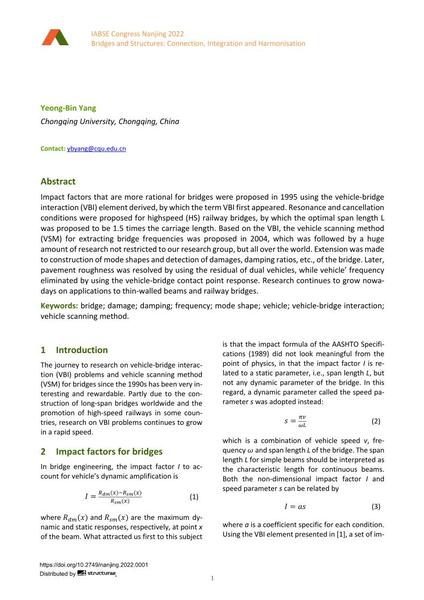Research on Vehicle-Bridge Interaction Dynamics since 1990s

|
|
|||||||||||
Détails bibliographiques
| Auteur(s): |
Yeong-bin Yang
(Chongqing University, Chongqing, China)
|
||||
|---|---|---|---|---|---|
| Médium: | papier de conférence | ||||
| Langue(s): | anglais | ||||
| Conférence: | IABSE Congress: Bridges and Structures: Connection, Integration and Harmonisation, Nanjing, People's Republic of China, 21-23 September 2022 | ||||
| Publié dans: | IABSE Congress Nanjing 2022 | ||||
|
|||||
| Page(s): | 1-4 | ||||
| Nombre total de pages (du PDF): | 4 | ||||
| DOI: | 10.2749/nanjing.2022.0001 | ||||
| Abstrait: |
Impact factors that are more rational for bridges were proposed in 1995 using the vehicle-bridge interaction (VBI) element derived, by which the term VBI first appeared. Resonance and cancellation conditions were proposed for highspeed (HS) railway bridges, by which the optimal span length L was proposed to be 1.5 times the carriage length. Based on the VBI, the vehicle scanning method (VSM) for extracting bridge frequencies was proposed in 2004, which was followed by a huge amount of research not restricted to our research group, but all over the world. Extension was made to construction of mode shapes and detection of damages, damping ratios, etc., of the bridge. Later, pavement roughness was resolved by using the residual of dual vehicles, while vehicle’ frequency eliminated by using the vehicle-bridge contact point response. Research continues to grow nowa- days on applications to thin-walled beams and railway bridges. |
||||
| Mots-clé: |
pont
|
||||
| Copyright: | © 2022 International Association for Bridge and Structural Engineering (IABSE) | ||||
| License: | Cette oeuvre ne peut être utilisée sans la permission de l'auteur ou détenteur des droits. |
||||
